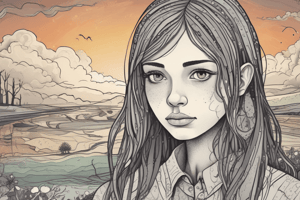Podcast
Questions and Answers
Which of the following symptoms is commonly associated with Persistent Depressive Disorder (P-DD) in children?
Which of the following symptoms is commonly associated with Persistent Depressive Disorder (P-DD) in children?
- Euphoria
- Uncontrollable laughter
- Constant feelings of sadness (correct)
- High self-esteem
What is the most common comorbid disorder found in children diagnosed with Persistent Depressive Disorder?
What is the most common comorbid disorder found in children diagnosed with Persistent Depressive Disorder?
- Attention Deficit Hyperactivity Disorder
- Anxiety disorder
- Major Depressive Disorder (correct)
- Bipolar Disorder
How does Persistent Depressive Disorder typically affect a child's social functioning?
How does Persistent Depressive Disorder typically affect a child's social functioning?
- Causes social withdrawal (correct)
- Enhances communication skills
- Fosters close friendships
- Promotes effective coping strategies
Children with Persistent Depressive Disorder are at high risk for developing which of the following disorders?
Children with Persistent Depressive Disorder are at high risk for developing which of the following disorders?
What is the most common age range for the onset of Persistent Depressive Disorder in children?
What is the most common age range for the onset of Persistent Depressive Disorder in children?
Which of the following cognitive theories suggests that depressed individuals interpret life events negatively?
Which of the following cognitive theories suggests that depressed individuals interpret life events negatively?
Which of the following is NOT considered a classic symptom of mania in children?
Which of the following is NOT considered a classic symptom of mania in children?
What percentage range represents the prevalence of bipolar disorder in youths aged 7-21?
What percentage range represents the prevalence of bipolar disorder in youths aged 7-21?
Which of the following co-occurring disorders is most commonly associated with bipolar disorder in children and adolescents?
Which of the following co-occurring disorders is most commonly associated with bipolar disorder in children and adolescents?
What is the significance of the onset of bipolar disorder before age 10?
What is the significance of the onset of bipolar disorder before age 10?
Which treatment intervention involves educating both the patient and their family?
Which treatment intervention involves educating both the patient and their family?
Mood fluctuations in bipolar disorder are suggested to be related to abnormalities in which areas of the brain?
Mood fluctuations in bipolar disorder are suggested to be related to abnormalities in which areas of the brain?
What is a key factor in diagnosing Major Depressive Disorder (MDD)?
What is a key factor in diagnosing Major Depressive Disorder (MDD)?
What is the prevalence of Major Depressive Disorder (MDD) in children aged 4-18?
What is the prevalence of Major Depressive Disorder (MDD) in children aged 4-18?
Which social impact is commonly associated with Major Depressive Disorder in youth?
Which social impact is commonly associated with Major Depressive Disorder in youth?
Which of the following disorders frequently co-occurs with Major Depressive Disorder?
Which of the following disorders frequently co-occurs with Major Depressive Disorder?
How does the prevalence of depression differ after puberty between genders?
How does the prevalence of depression differ after puberty between genders?
What characterizes Persistent Depressive Disorder (P-DD)?
What characterizes Persistent Depressive Disorder (P-DD)?
Which symptom is NOT typical of Major Depressive Disorder (MDD) in children?
Which symptom is NOT typical of Major Depressive Disorder (MDD) in children?
What is a common co-occurring disorder found in children with depression?
What is a common co-occurring disorder found in children with depression?
How does the experience of depression in infants typically manifest?
How does the experience of depression in infants typically manifest?
What impact does depression have on children's social relationships?
What impact does depression have on children's social relationships?
At what developmental stage do children typically start to exhibit symptoms such as self-blame and low self-esteem?
At what developmental stage do children typically start to exhibit symptoms such as self-blame and low self-esteem?
Which of the following is considered a characteristic of depressive disorders?
Which of the following is considered a characteristic of depressive disorders?
In which category is Dysthymic disorder classified?
In which category is Dysthymic disorder classified?
Flashcards are hidden until you start studying
Study Notes
Chronic Depressive Disorders
- Persistent Depressive Disorder (P-DD) is more chronic than Major Depressive Disorder (MDD).
- Symptoms include poor emotion regulation, persistent sadness, self-deprecation, low self-esteem, anxiety, irritability, anger, and temper tantrums.
- Children with both MDD and P-DD experience greater impairment than those with only one disorder.
Prevalence
- P-DD prevalence: about 1% in children and 5% in adolescents.
- MDD is the most common comorbid disorder with P-DD, affecting 70% of children diagnosed with Depression.
- 50% of children with P-DD have additional nonaffective disorders before dysthymia.
Onset, Course, and Outcome
- Typical onset for P-DD occurs around ages 11-12, with a long duration ranging from 2 to 5 years.
- Those with P-DD are at increased risk for developing MDD, anxiety disorders, and conduct disorders.
Associated Characteristics
- Intellectual and academic functioning may suffer due to difficulty concentrating, loss of interest, and decreased thought and movement speed.
- Cognitive biases include negative thinking, hopelessness, suicidal ideation, and pessimistic outlook on life.
- Social struggles include few close friendships, social withdrawal, and dysfunctional family relationships.
Depression and Suicide
- A significant number of youth with depression contemplate suicide, with females at considerable risk.
- Peak ages for first suicide attempt linked to depression are 13 and 14.
Theories of Depression
- Psychodynamic Theories: Focus on conversion of aggressive instincts into depressive affects due to loss of a love object.
- Behavioral Theories: Stress the role of environmental consequences and lack of positive reinforcement in depression onset.
Cognitive Theories
- Center on the link between negative thinking and mood; highlight "depressogenic" cognitions that contribute to depressive symptoms.
- The Hopelessness theory posits that individuals prone to depression engage in negative attributional styles.
Other Theories
- Explore concepts such as self-control, interpersonal influence, socioenvironmental factors, and neurobiological aspects.
Causes of Depression
- Multiple pathways to depression arise from genetic predispositions and environmental stressors.
- Familial behaviors, stressful life events, and prolonged emotional distress during childhood significantly contribute to its development.
Influences on Childhood Depression
- Risk of developing depression increases by 30-45% if a parent has depression.
- Neurobiological factors include abnormalities in brain regions governing emotional regulation and hormone dysregulation (HPA axis).
- Effective treatments include Cognitive Behavioral Therapy (CBT) and Interpersonal Psychotherapy for Adolescents (IPT-A); SSRIs are less effective than these therapeutic interventions.
Major Depressive Disorder (MDD)
- MDD prevalence in children aged 4-18 ranges from 2% to 8%, increasing two- to threefold during adolescence.
- High comorbidity rates with disorders like anxiety, ADHD, and conduct disorders are observed.
- Females are at greater risk post-puberty, and symptoms may appear gradually or suddenly, with average episodes lasting around eight months.
Bipolar Disorder in Children and Adolescents
- Symptoms may include mood volatility, psychomotor agitation, and classic mania signs such as racing thoughts.
- MDD can coexist with bipolar disorder; prevalence in youths aged 7-21 is between 0.5 to 2.5%.
- Treatment often involves monitoring, education, medication (like lithium), and psychotherapeutic interventions.
Overview of Mood Disorders
- Mood disorders encompass a spectrum from severe depression to extreme mania and are divided into depressive and bipolar disorders.
- Children’s depression can impair daily routines, social relationships, and academic performance, often accompanying anxiety or conduct disorders.
- The expression of depression evolves with age, becoming more identifiable in preteens through symptoms of low self-esteem and self-blame.
Studying That Suits You
Use AI to generate personalized quizzes and flashcards to suit your learning preferences.




